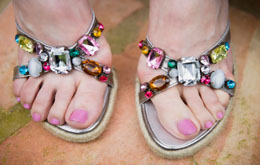Before going to the podiatrist for hammertoe treatment, look at the easy and simple treatment options that will relieve you off the distress.

It is observed that people with flat feet, a high arch bone, and women are susceptible to hammertoe, but the only reason is the footwear they use. Otherwise, no other reasons make them vulnerable to hammertoe. People with a flat foot usually have a broader front foot, and hence, they should avoid shoes that are compressive in nature to avoid foot problems. Similarly, ladies who are addicted to high heels make the feet arch too much, and longer hours and prolonged usage of such shoes may result in hammertoe. This article gives you some treatment options without going under the knife.
A hammertoe is defined as a toe that has curled due to a bend in the middle joint of a toe. It is often accompanied with a condition called the mallet toe. The only difference between a hammertoe and mallet toe is that it affects the upper joint of a toe as opposed to the middle joint in the hammer toe. A hammered toe is also known as clawed toe or crooked toe.
Causes
- Bunion
- Unnatural walk
- Genetic Defect
- Muscle imbalance
- Long second toe
- Stiff tendon
- Trauma
Symptoms
- Hammer or claw-like appearance of a toe.
- Mallet-like appearance of the end of the toe, in mallet toe cases.
- Can be painful in case it is irritated by a shoe.
- Can result in cramps in toes, foot, and leg due to the abnormal function of the tendons, in case of all the four toes' impairment.
- Pain and difficulty moving the toe.
- May cause corns or become hard, i.e., callous, by rubbing of the toe against the footwear.
- May cause deformation in the toe.
- May pose difficulty in walking or moving the toes.
- Infections like toenail fungus and ulcers can also occur.
- In severe cases a mallet toe, trigger toe, claw toe, or a hammertoe may create a downward pressure on the foot, which can result in hard skin and corns on the soles of the feet.
- Muscle cramps in the foot.
- Stiffness in the joints of the toe.
- Swelling around the joints.
- Redness around the joints.
Treatment
Surgery for hammertoe is required only when all the mentioned remedies fail to correct the hammertoe and ease the distress. The level of pain you experience, and the podiatrist will be best person to judge whether or not you need to go for surgery. A hammertoe has a chance of getting cured, i.e., become straightened if it is in the early stages, but once it crosses that stage, the joint becomes permanently fixed. In severe cases, it can hamper the ball of the foot dislocates the toe. The following are treatment options without surgery.
- Using a wide-front shoe to give the toes ample space and thus avoid cramping of the toes.
- Investing in shoes that provide cushioning and relieves pressure.
- Shoes that provide breathing space for enabling aeration are good to use as they can be helpful in avoiding skin infections.
- Wear shoes that help avoid friction between the toes.
- Using corn pads and cushions works for giving temporary relief.
- If you have a flat foot, you should use shoe inserts that will assist the foot muscles to work together.
This was all about hammertoe treatment. Keep in mind its causes, and watch out for its symptoms, so that it is detected at an early stage and causes you less trouble.
Disclaimer: The information provided in this article is solely for educating the reader. It is not intended to be a substitute for the advice of a medical expert.


 It is observed that people with flat feet, a high arch bone, and women are susceptible to hammertoe, but the only reason is the footwear they use. Otherwise, no other reasons make them vulnerable to hammertoe. People with a flat foot usually have a broader front foot, and hence, they should avoid shoes that are compressive in nature to avoid foot problems. Similarly, ladies who are addicted to high heels make the feet arch too much, and longer hours and prolonged usage of such shoes may result in hammertoe. This article gives you some treatment options without going under the knife.
It is observed that people with flat feet, a high arch bone, and women are susceptible to hammertoe, but the only reason is the footwear they use. Otherwise, no other reasons make them vulnerable to hammertoe. People with a flat foot usually have a broader front foot, and hence, they should avoid shoes that are compressive in nature to avoid foot problems. Similarly, ladies who are addicted to high heels make the feet arch too much, and longer hours and prolonged usage of such shoes may result in hammertoe. This article gives you some treatment options without going under the knife.